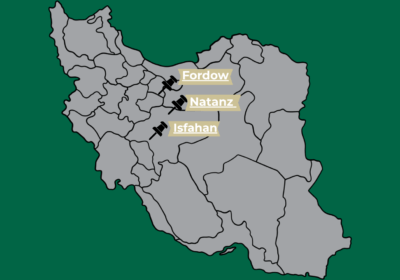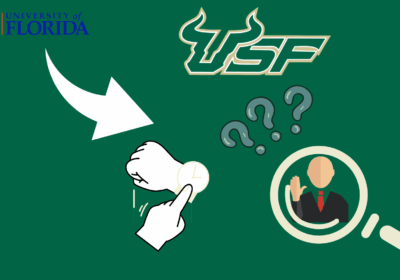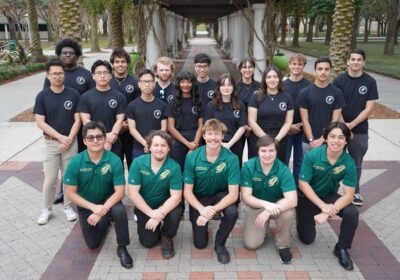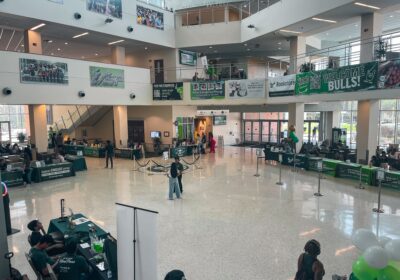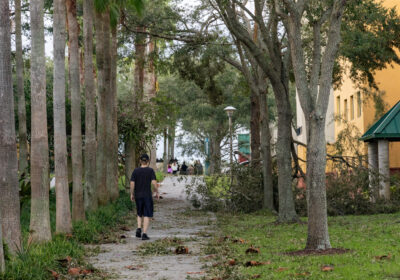Researchers seek to treat, cure rare genetic disease

Dr. Clifton Gooch, professor and chair of neurology at the USF Health Morsani College of Medicine, spoke at the
Friedreich’s Ataxia (FA) symposium Sept. 17 about progress toward developing a treatment for FA.
SPECIAL TO THE ORACLE
USF and pharmaceutical companies may be on the path to helping eradicate a rare genetic disease.
Researchers in USF’s Ataxia Research Center are currently working toward a cure for Friedreich’s ataxia (FA), a rare neurological condition affecting about one in 50,000 people for which no cure or approved treatment exists.
FA patients have a single mutated gene, known as the FXN gene, which leads to insufficient production of a protein called frataxin. This deficiency leads to loss of energy in the nerves and has debilitating effects for those afflicted with it, such as loss of coordination and balance, problems with hearing and vision and speech impairments.
“Many of these patients, by the time they’re in their twenties, will be wheelchair-bound, and many will die in their forties of heart disease,” said Dr. Clifton Gooch, professor and chairman of the Department of Neurology at the Morsani College of Medicine.
In late August, USF student Sam Bridgman spoke at the Muma College of Business’s annual scholarship luncheon. Bridgman, who received a full scholarship and internship to attend two years of the college’s MBA program, was diagnosed with FA at 15, according to a recent Tampa Tribune article.
Despite needing the use of a motorized wheelchair, Bridgman moved from Portland, Oregon to USF on his own and plans to graduate with an MBA and a master’s degree in sports and entertainment management.
The Friedreich’s Ataxia Research Alliance (FARA) and USF also recently hosted the seventh annual Friedreich’s Ataxia scientific symposium “Understanding Energy for A Cure” to raise awareness for FA research and progress in developing a cure.
According to a USF Health press release, the September 17 event attracted an audience of more than 500 between the Marshall Student Center Ballroom and a live streaming channel. The symposium featured speakers from FARA, FA patients and was the first year pharmaceutical companies were present at the event to discuss clinical trials for FA treatments.
USF Health was also a sponsor of FARA’s Energy Ball on September 19, a gala and auction to raise money for FA research and treatment.
“It’s a fun, high-energy gala. Plus, the symposium gives you the opportunity to learn what you are supporting and meet the people who benefit from it,” said Felicia DeRosa, FARA Fundraising Program Director.
The Energy Ball raised $1.7 million, a portion of which will be returned to the USF Ataxia Research Center in the form of grants for research trials, patient care, and awareness events. FARA will use the rest of the money to give grants to other research institutions and pay for patient transportation to its international network of FA treatment centers, including USF.
While Gooch said he began working with USF Ataxia Research Center Director Dr. Theresa Zesiewicz in 2008, almost all of USF’s ataxia research has focused on the basic science of the disease at the cellular level until last year. He said a typical drug could take 10 to 25 years to go from the initial concept to Food and Drug Administration (FDA) approval and deployment.
“(Human testing trials) are the hardest to get funded because the industry wants to see some proof of concept before they invest millions of dollars into a (larger) trial,” Gooch said.
According to the USF Health release, researchers in the USF Ataxia Research Center have eight FA clinical trials in progress.
For one proposed treatment, the Center is working with Agilis Biotherapeutics, a biopharmaceutical company present at the symposium, to test a gene therapy treatment to restore the function of the frataxin gene. If this treatment is successful, it could prevent progression of the disease and possibly reverse nerve damage. The treatment is expected to be submitted to the FDA in 2016.
This month, USF also enrolled the first patient in a trial held by Retrotope, a pharmaceutical company present at the symposium, investigating the safety of a potential drug for treating FA, according to the USF Health release. USF and the University of California, Los Angeles will be the only two sites in the human testing portion of the study.


